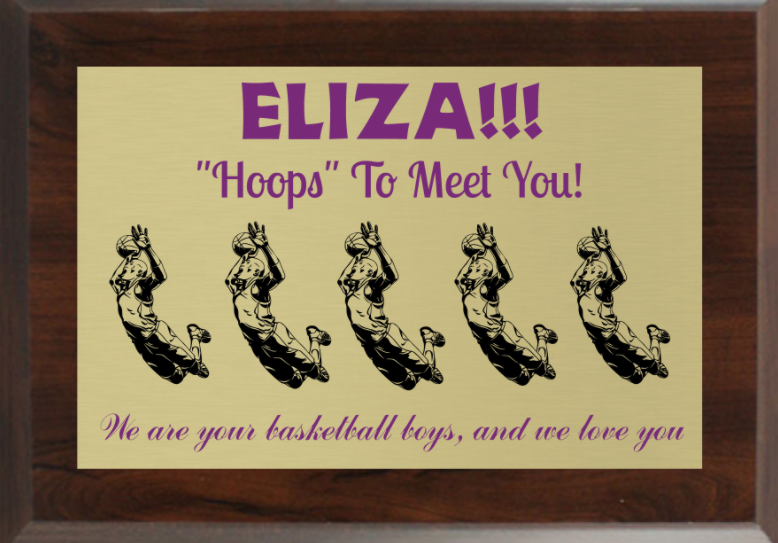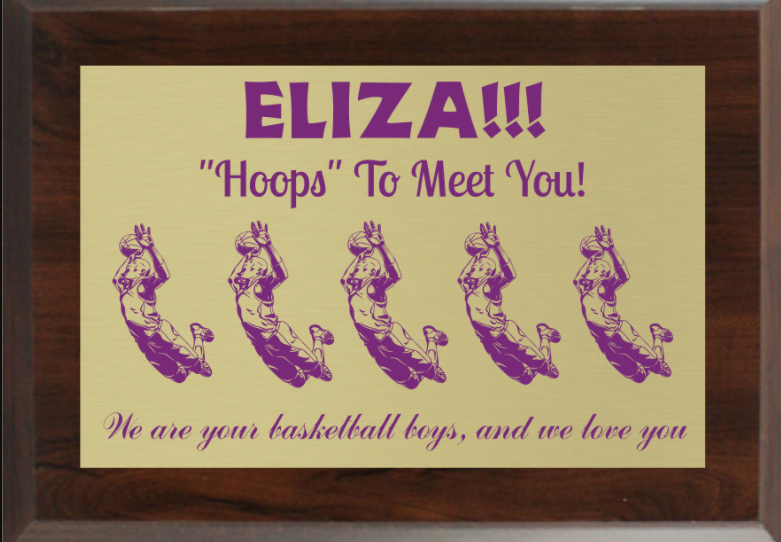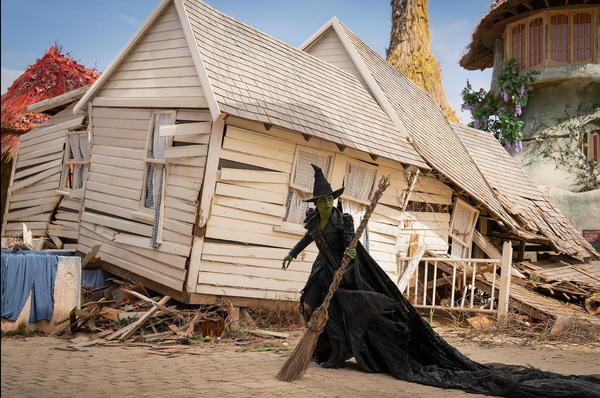I am an artistic genius, and my medium is custom-designed plaques
How I forged a life-long friendship and weirded out the customer service representatives of Plaquemaker dot com, one plaque at a time

So I was upset that I hadn’t been submitted for consideration for a Pulitzer Prize. I didn’t know why I felt this was important, beyond the fact that I think I should be submitted for all prizes, and I think most of the conversations I have should be about how I’m great.
My friend Eliza asked me, “Well, what do you get if you win the Pulitzer Prize?”
“Money,” I said. “And a plaque. But I’ve won a plaque before. I won a South Dakota Newspaper Award in 1999, and I got a plaque for that. I still have it somewhere.”
“I’ve never won a plaque,” Eliza said wistfully. And then the madness began.
I googled “make plaques,” and I discovered that the top result was a site named Plaquemaker dot com, which felt a little too easy, like I probably could have arrived at that name by typing random assemblages of words into the address bar. But I clicked on the link and discovered a calling I didn’t know I had.
Plaquemaker will let you custom design plaques to your heart’s content, and the cheapest plaques are well beneath $20. I could unleash my mind on a blank canvas? And create beautiful works of art? And spend less than $20 to make my friend happy? There was only one thing to do: I asked Eliza her favorite color. (Because Eliza, like me, is a trans woman, she said “purple,” because all trans women’s favorite color is purple.) (Seriously, my favorite color used to be red, and then I started taking estrogen.)
The first plaque I designed was simple, beautiful, uncomplicated. I call this plaque my minimalist period.

The “seal” represents the fact that I think Eliza seems like she might like seals. The name “Eliza” is Eliza’s name. The purple coloring is because Eliza likes purple. The three exclamation marks are because I think Eliza is neat.
But in designing this plaque, I learned that Plaquemaker dot com and I were going to have a reckoning. For Plaquemaker dot com, typically used for plaques like this sample one from their website—

—wasn’t at all prepared for my Dadaist bending of traditional plaque aesthetics. Plaquemaker dot com kept trying to make sense of things.
This is the initial proof they sent me.

What the shit is that? Honestly, what the shit is that? The seal isn’t purple? Who do these people think my friend Eliza is??? Thus began another tradition — me emailing the Plaquemaker customer service people to help me create my art.

Fortunately, the Plaquemaker customer service team was on it, and soon, Eliza had her plaque.
I just asked her how she felt when she received the plaque, and she said: “I think it was the day the Trump administration announced the new Health and Human Services rules, and it was the Friday before the Supreme Court ruling no one thought would go our way. It felt like the world was ending. Then I get a knock at my door. And I thought the plaque would take a month to get there. But I went to get the package, and it was the plaque. It was like a little, beaming light of goodness in a dark world.”
Creating tiny rays of hope in a world that feels suffused in darkness is a mission I am dedicated to. Another mission I’m dedicated to is making every moment of my life feel as much like it’s part of a sitcom plot nobody else can see. Plus, as what we in the industry call “a creative,” I had become fascinated by Plaquemaker’s design tools. I was quite sure I could perfect my work in this new medium.
And then I discovered that I could control individual colors within a piece of clip art. And I found a baby. And I remembered Eliza liked purple. And then. Oh then.

As you can see, this is a development of my original themes. The color purple still predominates, because Eliza likes purple, but I have included several other elements. For one thing, I have added “the best” to indicate that Eliza is, indeed, the best. For another, I have added Santa (to represent the false dialectic between “good” and “evil” and the oppressive ways in which it holds down trans people) and a chicken (to represent a lean, delicious source of protein).
And then I have added a new character. The Baby.
The Baby is something I stumbled upon by accident. I started clicking around and changing colors and realized I could change each and every color until we had a strange, alien-like, Grimace-like being, who was there to wish Eliza well. The Baby does not mean harm. The Baby does not mean help. The Baby consumes, and The Baby expels. The Baby is a pure vision of a world without a center, the kind of chaotic world in which “Eliza” (the central figure in this metaphorical story) finds herself cast adrift.
Plaquemaker once again didn’t comprehend my vision.

You might notice that baby looks a lot like an actual baby and not a horrifying purple demon child. Obviously, this would not do. I wrote a sternly worded email.

Does that email sound like the work of an artist who has seen her work tossed aside by those who will never understand it? Or does it sound like an email from someone who is perhaps beginning to cause confused whispers around the Plaquemaker customer service department? Yes?
Plaquemaker made the corrections. Eliza has her plaque. The Baby is its proper purple. All is well in our world.
Like many other media, plaques can be collaborative, which led to my third masterpiece, the most recently completed image. Where my last images had begun with a thematic imperative, a message to impart to the world, this image would have a strong narrative thrust — the central character (the one known as Eliza), terrified by The Baby, would seek to put order into the world. In so doing, she would meet men willing to defend her on the court. The basketball court.
Enter the Basketball Boys.
I first will show you the initial proof sent to me by Plaquemaker. See if you can guess what caused me to write back to the customer service department requesting changes to the initial design.

Did you guess—

(Note the subtle escalation: Eliza is now not just a friend but “my best friend.” Will Plaquemaker similarly escalate? Only time will tell.)
At this point, the staff of Plaquemaker have become a willing participant in the meta-narrative of the art’s creation. Every time I submit a new design, they send it back with a key element that is not purple, just to check if I am paying attention. And every time, I catch their ruse. If Eliza is goodness and The Baby is chaos and the Basketball Boys are order, then Plaquemaker’s customer service department fills a trickster god-esque role in this new cosmology.
This is the plaque as it was shipped to Eliza.

Eliza was pleased.
This is the third in a series of plaques my favorite stalker @emilyvdw sent me pic.twitter.com/NQaE8zu61yAugust 31, 2020
(We also wanted to let Plaquemaker know how happy we were with their diligent levels of customer service.)
It is important to note that I am neither mad nor frustrated with the Plaquemaker people. They have a role to play in this saga, and I have to imagine they are deeply confused by everything that has happened. This is not just a story about the plaques or my creation of the plaques or the narrative that is unfolding within them, one plaque at a time. No, this is also a story about how Plaquemaker and I work alongside each other to create genius, about the ways that limitations can spur greater and greater acts of creation.
I had still another collaborator on the “basketball boys” plaque — my actual best friend, Cassie, aka the first person who ever knew me as me, where I knew her as her. Before Cassie’s involvement, the basketball boys plaque had the boys, the name Eliza, and the boys’ declaration of love. But it lacked something. Enter Cassie, who in a brief bolt of inspiration, typed out: “Hoops to meet you.” So is art made. So does creation arise from the primordial soup.
(Somewhere in here, I completed a Plaquemaker customer survey and gave only high marks to everyone I had interacted with, along with a series of questions in which I talked a lot about how much my best friend loves purple. Alas, that survey is lost to time.)
I do not know what my next work will be. I am weighing a number of options, including new figures in my cosmology. One, I call “The Green Baby.”

The other, I call simply “TheDog.”

I am not yet wholly satisfied with either design, which is why they remain only in my imagination and in the endless possibility space of the Plaquemaker dot com design studio. Someday, they will be born. Both The Green Baby and TheDog are important figures in the cosmology I am building, and both plaques keep to the already established mythos of Eliza (the good friend) and the color purple (the good friend’s favorite). Will the seal return? Can the basketball boys hold off The Baby? All remains to be seen.
We are telling a story together, Plaquemaker and I. And I cannot wait to see how this story ends.
What I’ve been up to: I hope that this enjoyable tale of slightly terrifying friendship among trans women primes you to read this much more heartwarming tale of friendship and community among trans people, found online in the anonymizing spaces of Twitter and Reddit. I learned a lot reporting it!
In the years to come, Day would experiment with her own anonymous online profiles as she slowly fumbled toward coming out and beginning her transition in the early 2010s. She had public personas on sites like LiveJournal and Myspace in her former name, but she was much more active and made more friends through the accounts she created under a woman’s name and persona. By the time she talked to me for this story, she’d updated all her accounts to have the name Emily Day. She was out and living her life as a woman, a life she documents with some regularity on Twitter.
The use of online spaces by trans people to create anonymous identities that better match their internal selves is as old as the internet itself. You can make a real argument that trans people popularized the very idea of adopting anonymous identities online in the early 1990s on then-popular Usenet listservs. And in 2020, there are many more platforms to use for creating a new digital self than there were when Day stumbled onto that message board.
But few platforms have been as successful at building a space for that kind of experimentation as Twitter and Reddit, where many trans people (though mostly trans women) create pre-coming out accounts that they often begin to use more and more as their legal identities cease to feel as real to them.
I also wrote about how online video editing makes me think about death, because my personal brand is strong.
Read me: I recently rewatched Starship Troopers (with the aforementioned “Cassie”), and my gosh, does that movie seem prescient in 2020! David Roth had many of the same thoughts in an excellent New Yorker essay:
Where “RoboCop” and “Total Recall” exist in grimy, crowded, dangerous futures that look and feel like degraded versions of the already degrading present, Verhoeven’s bizarre masterwork “Starship Troopers,” from 1997, is set in the more distant days of the twenty-third century—and, it quickly emerges, long after the end of history. “This year, we explored the failure of democracy, how the social scientists brought our world to the brink of chaos,” Rasczak, a history teacher (played by the Verhoeven favorite Michael Ironside), barks at his high-school students in an early scene. “We talked about the veterans and how they took control, and imposed the stability that has lasted for generations since.” Rasczak himself is a disfigured war veteran, as are all of his fellow-teachers, and their job is to steer their students toward enlisting in a galaxy-wide war against a species of giant, lethal bug. In this universe, humankind is divided into “civilians” and “citizens”; only citizens have the right to vote, and citizenship can be won only through “federal service” in the military. “Something given has no value,” Rasczak explains. “When you vote, you are exercising political authority. You are using force. And force, my friends, is violence—the supreme authority from which all other authorities derive.” Daily life in the Federation may be cleaner and brighter than in any of Verhoeven’s other futures, but every ambiguity has been displaced by the certitudes, coercions, and doublespeak of endless, totalizing conflict.
Watch me: I have been vaguely rewatching the 1990s Stephen King miniseries Storm of the Century (based on an original screenplay written by the horror master), and you know what? It mostly holds up! It’s probably the best of the many King miniseries of the ‘80s and ‘90s.
And another thing… Anybody wanna buy this house with me? It seems like a good “riding out the apocalypse” kinda place. It even has a nice, tall tower from which to survey one’s domain!
This week’s reading music: “Existential Crisis Hour!” by Kilo Kish
Episodes is published once per week and is about whatever I feel like that particular week. Suggest topics for future installments via email or on Twitter. Read more of my work at Vox.




